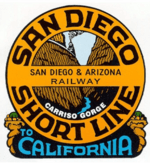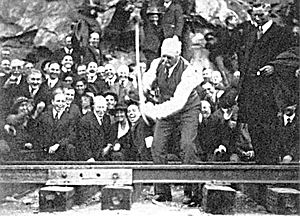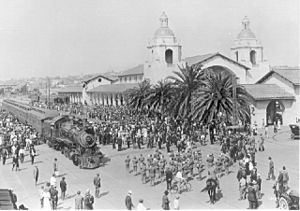San Diego and Arizona Railway facts for kids
 |
|
| Overview | |
|---|---|
| Headquarters | San Diego, California |
| Reporting mark | SDA |
| Locale | California Mexico |
| Dates of operation | 1919–1984 |
| Successor | Southern Pacific |
| Technical | |
| Track gauge | 4 ft 8 1⁄2 in (1,435 mm) standard gauge |
| Length | 129 miles (208 kilometers) |
The San Diego and Arizona Railway (SDA) was a special railroad in the U.S. It was about 148 miles long. A businessman named John D. Spreckels started it. People called it "The Impossible Railroad." This was because it was very hard to build. The railway connected San Diego to El Centro. This meant people could travel east without going through Los Angeles first. They could connect to bigger train lines there.
The idea for the railway started in 1906. Building began in 1907. Many things caused delays, like World War I. The railway was finally finished in 1919. Bad weather and other problems caused damage to the tracks. This made it hard for the company to make money. In 1932, Spreckels' family sold the railway. It was bought by the Southern Pacific company. They renamed it the San Diego and Arizona Eastern Railway (SD&AE).
Contents
Building the Impossible Railroad
The San Diego and Arizona Railway company was officially started on December 14, 1906. The first groundbreaking ceremony happened on September 7, 1907. It took a long time to build the railway. There were many delays.
Mexican revolutionaries caused some problems. Also, the government got involved during World War I. All these things pushed back the completion date. Finally, on November 15, 1919, the "golden spike" was driven. This special event marked the railway's completion.
The first passenger train left Campo on November 30, 1919. It traveled all the way from El Centro to San Diego's downtown Union Station. This trip was for the official opening of the line on December 1, 1919.
The railway cost about $18 million to build. This was much more than the first guess of $6 million. A tough 11-mile part through Carrizo Gorge cost over $4 million alone. This section had 17 tunnels. In total, the railway had 21 tunnels.
The Railway's Path
The tracks started in downtown San Diego. They went south and crossed the U.S.-Mexico border at San Ysidro. From there, the line went east through Tijuana. Then it turned northeast through Tecate. It crossed back into the U.S. at Campo.
To build and keep up the 44-mile part in Mexico, the SD&A created a special company. It was called the Ferrocarril Tijuana y Tecate, S.A. de C.V. East of Campo, the railway went through Clover Flats. It then crossed the Coast Range mountains. After that, it went down through the amazing but dangerous Carrizo Gorge. This gorge was the hardest part for the builders.
The SD&A line officially ended in Seeley. But the railway had rights to run trains further east to El Centro. It could also go south to Calexico. There were also smaller lines. These went from downtown San Diego to Lakeside. Another line went around San Diego Bay. It served Coronado Heights, Coronado, and North Island.
Challenges and Changes
The railway faced many problems. Heavy rainstorms caused damage. Landslides and fires also hurt the tracks. Border closings with Mexico also made things difficult. There were also acts of vandalism. All these issues cost the company a lot of money.
In 1932, the Spreckels family had financial difficulties. They had to sell their part of the company. The Southern Pacific company bought it for $2.8 million. They then renamed the railway the San Diego and Arizona Eastern Railway (SD&AE).
Timeline of the Railway
- 1906: John D. Spreckels announces he will build the San Diego and Arizona Railway (SD&A). It will be a 148-mile line between San Diego and El Centro.
- September 7, 1907: Building begins for the SD&A in downtown San Diego.
- 1909: The Mexican Government asks the SD&A to form a special company. This company will build and manage the 44-mile railway part in Mexico.
- July 29, 1910: The first passenger train on the SD&A enters Mexico.
- 1911: Mexican revolutionaries attack SD&A construction crews. They try to get soldiers and supplies.
- 1916: A "Great Flood" washes away parts of the railway lines. World War I makes building materials much more expensive.
- 1917: The U.S. government takes control of all railroads for the war. They stop building the SD&A. But later, Spreckels gets special permission to continue. This is because the railway will help a military base.
- November 15, 1919: The "golden spike" is driven. The SD&A is finished. It cost $18 million, which was three times more than planned.
- December 1, 1919: The first passenger train arrives in San Diego from El Centro. This is for the official opening ceremony.
- December 10, 1919: Direct Pullman train service to Chicago begins. These cars connect to another train in Yuma.
- 1922: A new logo is used. It shows a scene in the Carrizo Gorge and says "San Diego Short Line."
- 1926, 1927, 1929: Heavy rains destroy large parts of the tracks east of San Diego.
- 1928: Train service to La Mesa and Lakeside stops. A movie called Beggars of Life is filmed along the railway.
- January 1932: A fire breaks out in Tunnel 3 in Baja California. The tunnel collapses. Repairs take 45 days.
- March 27, 1932: A huge mountain slide blocks the line near Tunnel 15. Repairs are done by July 6. Train services start again.
- October 22, 1932: Tunnel 7 burns and is no longer used.
- October 24, 1932: Spreckels' family sells their part of the SD&A to the Southern Pacific Transportation Company.
- January 23, 1933: A new track is built around the cliff at Tunnel 7. The line reopens.
- February 1, 1933: The San Diego and Arizona Eastern Railway takes over all operations of the SD&A.
- December 1985: The Pacific Southwest Railway Museum brings back the San Diego & Arizona Railway name. They start running special "Golden State" passenger trains. These trips still happen today.



